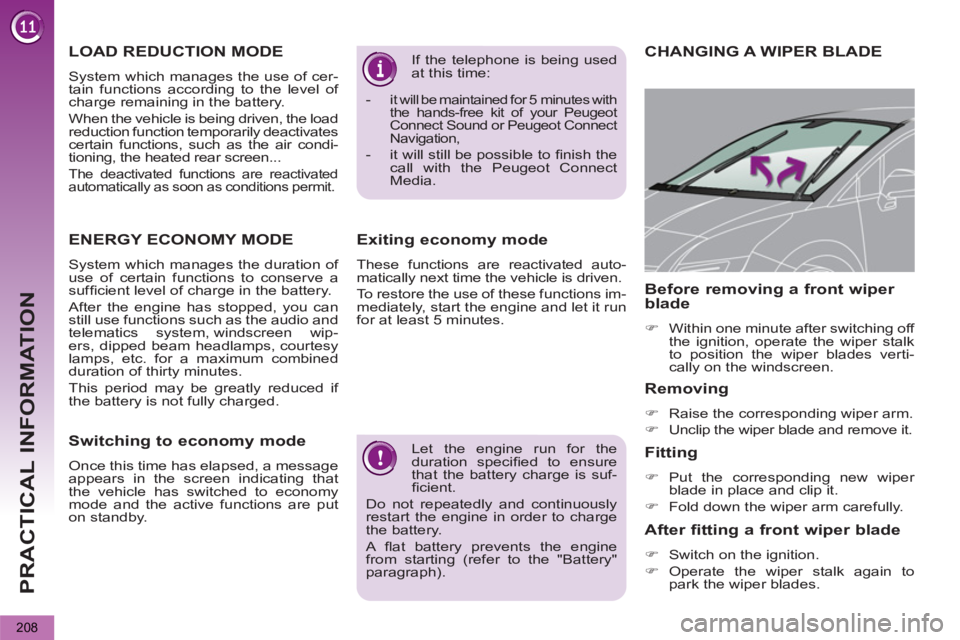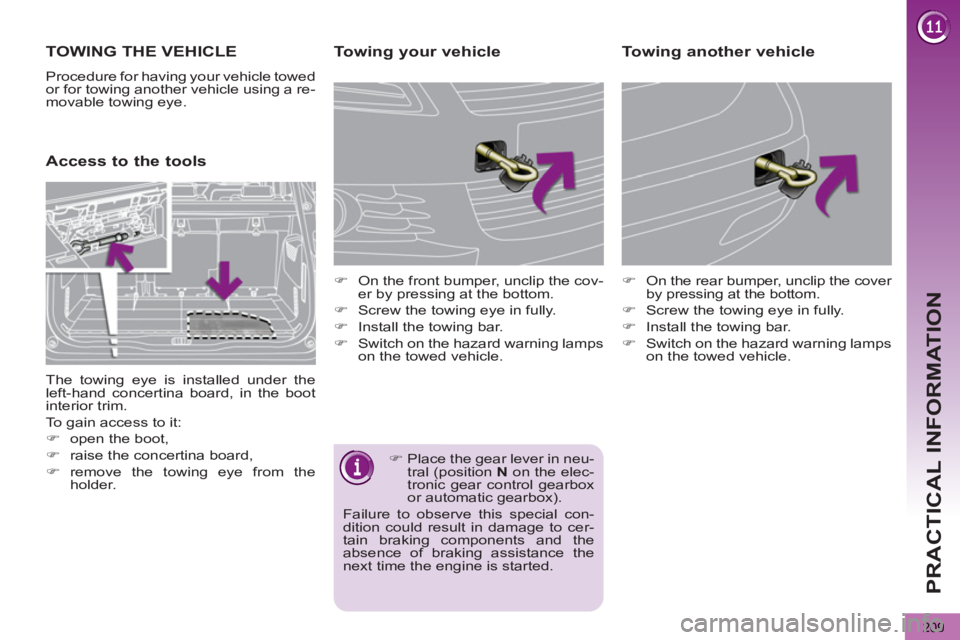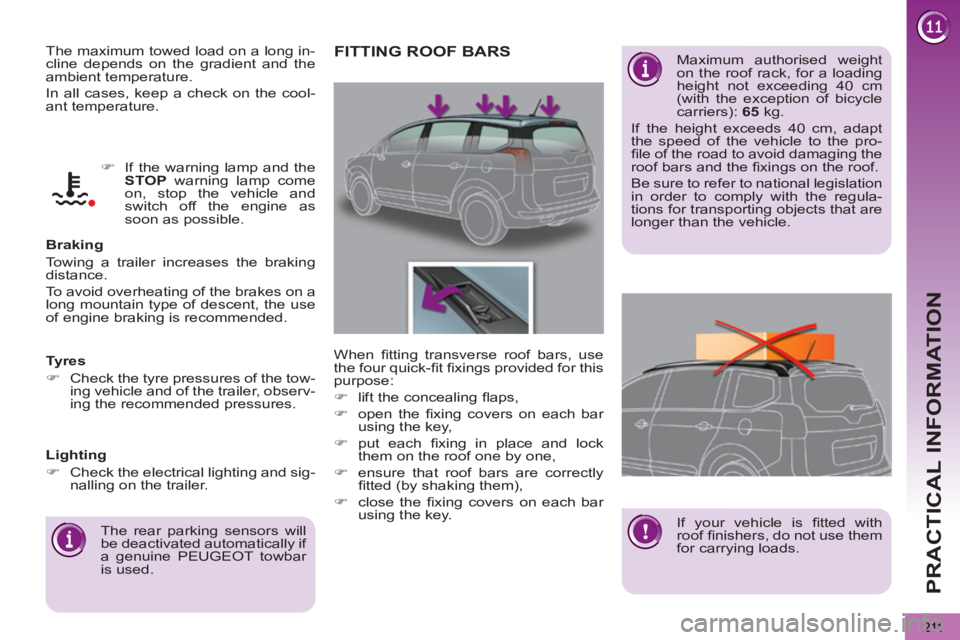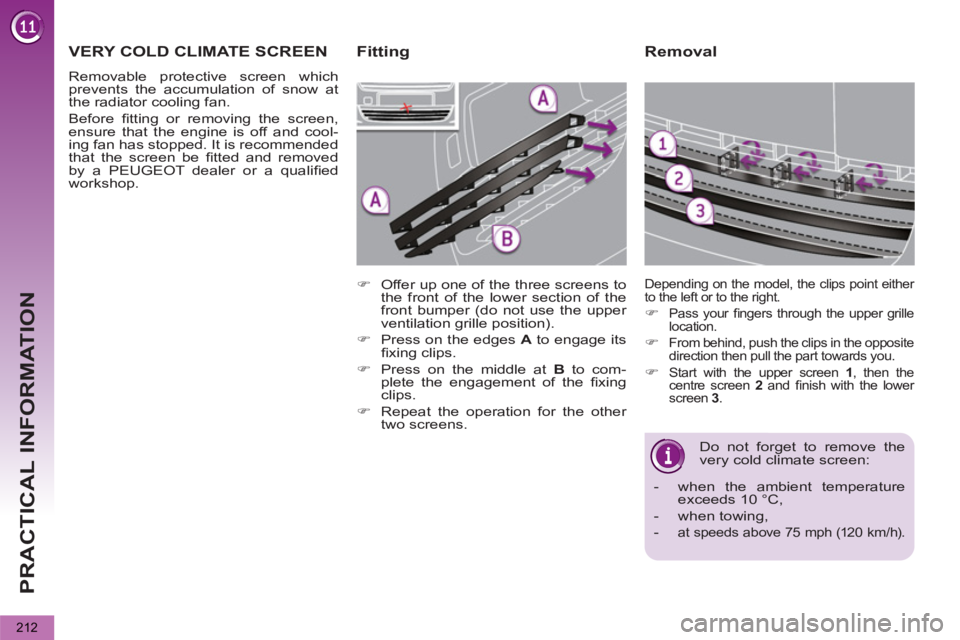2011 PEUGEOT 5008 engine
[x] Cancel search: enginePage 210 of 340

PRACTICAL INFORMATION
208
Let the engine run for the
duration specifi ed to ensure
that the battery charge is suf-
fi cient.
Do not repeatedly and continuously
restart the engine in order to charge
the battery.
A fl at battery prevents the engine
from starting (refer to the "Battery"
paragraph). If the telephone is being used
at this time:
- i
t will be maintained for 5 minutes with
the hands-free kit of your Peugeot
Connect Sound or Peugeot Connect
Navigation,
- it will still be possible to fi nish the
call with the Peugeot Connect
Media.
Exiting economy mode
These functions are reactivated auto-
matically next time the vehicle is driven.
To restore the use of these functions im-
mediately, start the engine and let it run
for at least 5 minutes.
CHANGING A WIPER BLADE
Removing
�)
Raise the corresponding wiper arm.
�)
Unclip the wiper blade and remove it.
Fitting
�)
Put the corresponding new wiper
blade in place and clip it.
�)
Fold down the wiper arm carefully.
Before removing a front wiper
blade
�)
Within one minute after switching off
the ignition, operate the wiper stalk
to position the wiper blades verti-
cally on the windscreen.
After fitting a front wiper blade
�)
Switch on the ignition.
�)
Operate the wiper stalk again to
park the wiper blades.
LOAD REDUCTION MODE
System which manages the use of cer-
tain functions according to the level of
charge remaining in the battery.
When the vehicle is being driven, the load
reduction function temporarily deactivates
certain functions, such as the air condi-
tioning, the heated rear screen...
The deactivated functions are reactivated
automatically as soon as conditions permit.
ENERGY ECONOMY MODE
System which manages the duration of
use of certain functions to conserve a
suffi cient level of charge in the battery.
After the engine has stopped, you can
still use functions such as the audio and
telematics system, windscreen wip-
ers, dipped beam headlamps, courtesy
lamps, etc. for a maximum combined
duration of thirty minutes.
This period may be greatly reduced if
the battery is not fully charged.
Switching to economy mode
Once this time has elapsed, a message
appears in the screen indicating that
the vehicle has switched to economy
mode and the active functions are put
on standby.
Page 211 of 340

PRACTICAL INFORMATION
209
TOWING THE VEHICLE
Procedure for having your vehicle towed
or for towing another vehicle using a re-
movable towing eye.
Access to the tools
Towing your vehicle
�)
On the front bumper, unclip the cov-
er by pressing at the bottom.
�)
Screw the towing eye in fully.
�)
Install the towing bar.
�)
Switch on the hazard warning lamps
on the towed vehicle.
�)
On the rear bumper, unclip the cover
by pressing at the bottom.
�)
Screw the towing eye in fully.
�)
Install the towing bar.
�)
Switch on the hazard warning lamps
on the towed vehicle.
Towing another vehicle
The towing eye is installed under the
left-hand concertina board, in the boot
interior trim.
To gain access to it:
�)
open the boot,
�)
raise the concertina board,
�)
remove the towing eye from the
holder.
�)
Place the gear lever in neu-
tral (position N
on the elec-
tronic gear control gearbox
or automatic gearbox).
Failure to observe this special con-
dition could result in damage to cer-
tain braking components and the
absence of braking assistance the
next time the engine is started.
Page 212 of 340

PRACTICAL INFORMATION
210
TOWING A TRAILER, A CARAVAN, ETC.
Your vehicle is primarily designed for
transporting people and luggage, but it
may also be used for towing a trailer.
Driving advice
Side wind
�)
Take into account the increased
sensitivity to side wind.
Cooling
Towing a trailer on a slope increases
the temperature of the coolant.
As the fan is electrically controlled, its
cooling capacity is not dependent on
the engine speed.
�)
To lower the engine speed, reduce
your speed.
Towbar suitable for the attachment of a
trailer or caravan with additional lighting
and signalling.
Distribution of loads
�)
Distribute the load in the trailer so
that the heaviest items are as close
as possible to the axle and the nose
weight approaches the maximum
permitted without exceeding it.
Air density decreases with altitude, thus
reducing engine performance. Above
1 000 metres, the maximum towed load
must be reduced by 10 % for every
1 000 metres of altitude.
Refer to the "Technical Data" section for
details of the weights and towed loads
which apply to your vehicle. Driving with a trailer places greater de-
mands on the towing vehicle and the
driver must take particular care.
We recommend the use of
genuine PEUGEOT towbars
and their harnesses that have
been tested and approved from the
design stage of your vehicle, and that
the fi tting of the towbar is entrusted
to a PEUGEOT dealer or a qualifi ed
workshop.
If the towbar is not fi tted by a
PEUGEOT dealer, it is imperative
that it is fi tted in accordance with the
vehicle manufacturer's instructions.
General
recommendations
Observe the legislation in force in
your country.
Ensure that the weight of the tow-
ing vehicle is higher than that of the
towed vehicle.
The driver must stay at the wheel of
the towed vehicle.
Driving on motorways and fast roads
is prohibited when towing.
When towing a vehicle with all four
wheels on the ground, always use an
approved towing bar; rope and straps
are prohibited.
When towing a vehicle with the en-
gine off, there is no longer any power
assistance for braking or steering.
In the following cases, you must al-
ways call on a professional recovery
service:
- vehicle broken down on a motor-
way or fast road,
- when it is not possible to put the
gearbox into neutral, unlock the
steering, or release the parking
brake,
- towing with only two wheels on
the ground,
- where there is no approved towing
bar available...
Page 213 of 340

PRACTICAL INFORMATION
211
The maximum towed load on a long in-
cline depends on the gradient and the
ambient temperature.
In all cases, keep a check on the cool-
ant temperature.
Braking
Towing a trailer increases the braking
distance.
To avoid overheating of the brakes on a
long mountain type of descent, the use
of engine braking is recommended.
Tyres
�)
Check the tyre pressures of the tow-
ing vehicle and of the trailer, observ-
ing the recommended pressures.
Lighting
�)
Check the electrical lighting and sig-
nalling on the trailer.
The rear parking sensors will
be deactivated automatically if
a genuine PEUGEOT towbar
is used.
�)
If the warning lamp and the
STOP
warning lamp come
on, stop the vehicle and
switch off the engine as
soon as possible.
FITTING ROOF BARS
Maximum authorised weight
on the roof rack, for a loading
height not exceeding 40 cm
(with the exception of bicycle
carriers): 65
kg.
If the height exceeds 40 cm, adapt
the speed of the vehicle to the pro-
fi le of the road to avoid damaging the
roof bars and the fi xings on the roof.
Be sure to refer to national legislation
in order to comply with the regula-
tions for transporting objects that are
longer than the vehicle.
When fi tting transverse roof bars, use
the four quick-fi t fi xings provided for this
purpose:
�)
lift the concealing fl aps,
�)
open the fi xing covers on each bar
using the key,
�)
put each fi xing in place and lock
them on the roof one by one,
�)
ensure that roof bars are correctly
fi tted (by shaking them),
�)
close the fi xing covers on each bar
using the key.
If your vehicle is fi tted with
roof fi nishers, do not use them
for carrying loads.
Page 214 of 340

PRACTICAL INFORMATION
212
Removal
Do not forget to remove the
very cold climate screen:
- when the ambient temperature
exceeds 10 °C,
- when towing,
-
at speeds above 75 mph (120 km/h).
Depending on the model, the clips point either
to the left or to the right.
�)
Pass your fi ngers through the upper grille
location.
�)
From behind, push the clips in the opposite
direction then pull the part towards you.
�)
Start with the upper screen 1
, then the
centre screen 2
and fi nish with the lower
screen 3
.
VERY COLD CLIMATE SCREEN
Removable protective screen which
prevents the accumulation of snow at
the radiator cooling fan.
Before fi tting or removing the screen,
ensure that the engine is off and cool-
ing fan has stopped. It is recommended
that the screen be fi tted and removed
by a PEUGEOT dealer or a qualifi ed
workshop.
�)
Offer up one of the three screens to
the front of the lower section of the
front bumper (do not use the upper
ventilation grille position).
�)
Press on the edges A
to engage its
fi xing clips.
�)
Press on the middle at B
to com-
plete the engagement of the fi xing
clips.
�)
Repeat the operation for the other
two screens.
Fitting
Page 216 of 340

TECHNICAL DATA
214
ENGINES AND GEARBOXES
Petrol engine
1.6 litre VTi
120 hp
1.6 litre THP
156 hp
Gearbox
Manual
(5-speed)
Manual
(6-speed)
Automatic
(6-speed)
Cubic capacity (cc)
1 598
1 598
Bore x stroke (mm)
77 x 85.8
77 x 85.8
Max power: EU standard (kW)
88
11 5
Max power engine speed (rpm)
6 000
6 000
Max torque: EU standard (Nm)
160
240
Max torque engine speed (rpm)
4 250
1 400
Fuel
Unleaded
Unleaded
Catalytic converter
yes
yes
OIL CAPACITIES (in litres)
Engine (with fi lter replacement)
4.25
4.25
Gearbox - Final drive
-
-
Page 217 of 340

TECHNICAL DATA
*
The kerb weight is equal to the unladen weight + driver (75 kg).
**
The weight of the braked trailer can be increased, within the GTW limit, if the GVW of the towing vehicle is reduced by an
equal amount; warning, towing using a lightly loaded towing vehicle may have an adverse effect on its road holding.
WEIGHTS AND TOWED LOADS (in kg)
Petrol engine
1.6 litre VTi
120 hp
1.6 litre THP
156 hp
Gearbox
Manual
(5-speed)
Manual (6-speed)/
Automatic (6 speed)
Seats
5
7
5
7
- Unladen weight
1 427
1 454
1 460
1 490
- Kerb weight *
1 502
1 532
1 535
1 565
- Payload
573
736
590
735
- Gross vehicle weight (GVW)
2 000
2 190
2 050
2 225
- Gross train weight (GTW)
on a 12% gradient
3 200
3 290
3 400
3 425
- Braked trailer (within GTW limit)
on a 10% or 12% gradient
1 200
1 100
1 350
1 200
- Braked trailer ** (with load transfer
within the GTW limit)
1 400
1 550
1 500
- Unbraked trailer
750
750
- Recommended nose weight
70
70
The GTW and towed load values indicated are valid up to a maximum altitude of 1 000 metres; the towed load mentioned
must be reduced by 10% for each additional 1 000 metres of altitude.
The speed of a towing vehicle must not exceed 60 mph (100 km/h) (comply with the legislation in force in your country).
High ambient temperatures may result in a reduction in the performance of the vehicle to protect the engine; if the ambient
temperature is above 37 °C, limit the towed load.
Page 218 of 340

TECHNICAL DATA
ENGINES AND GEARBOXES
Diesel engine
1.6 litre Turbo e-HDi
110 hp
2 litre Turbo HDi
150 hp
2 litre Turbo HDi
163 hp
Gearbox
Manual
(6-speed)
Electronic gear control
(6-speed)
Manual
(6-speed)
Automatic
(6-speed)
Cubic capacity (cc)
1 560
1 997
Bore x stroke (mm)
75 x 88.3
85 x 88
Max power: EU standard (kW)
82
110/120
Max power engine speed (rpm)
4 000
3 750
Max torque: EU standard (Nm)
270
320/340
Max torque engine speed (rpm)
1 750
2 000
Fuel
Diesel
Diesel
Catalytic converter
yes
yes
Particle emission fi lter
yes
yes
OIL CAPACITIES (in litres)
Engine (with fi lter replacement)
3.75
-